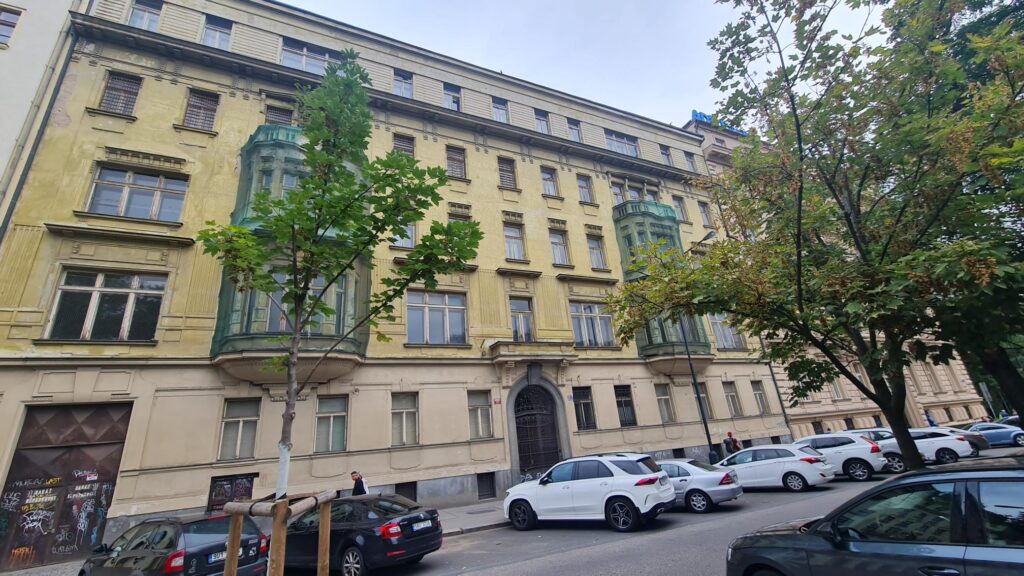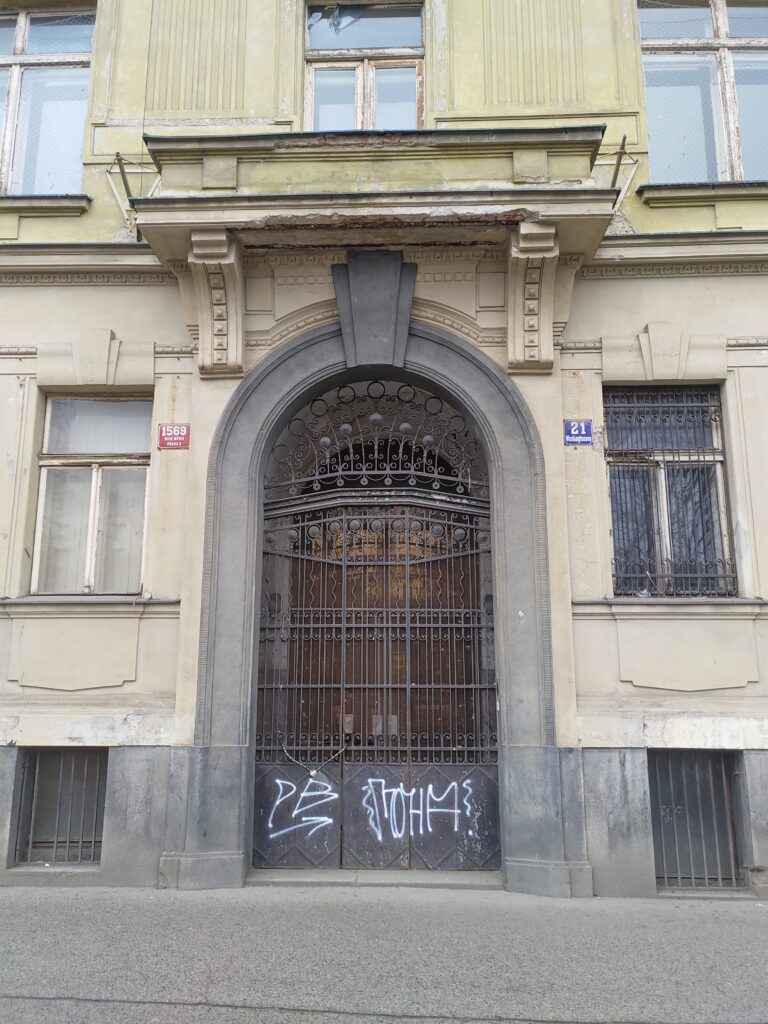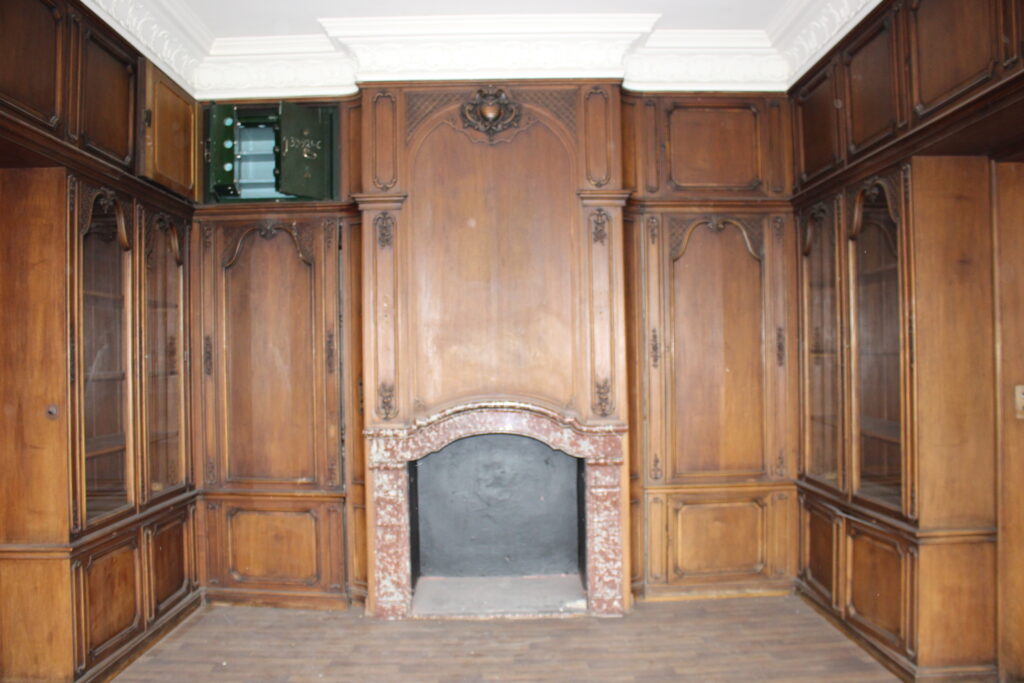The Premises of the Czech Language Institute
Building Washingtonova Street 1569/21, Prague 1

On 1 September 2023, the Institute assumed ownership of a building located at 1569/21 Washingtonova Street in the Prague 1 district. The Office for Government Representation in Property Affairs granted the building to the Institute. Due to its role in fulfilling public and state needs, the Institute received the building free of charge. However, it is required to renovate the building within 6 years and begin operating in the building as soon as the work is completed. Immediately after assuming ownership of the building, the Institute initiated the renovation project. Currently, the Institute’s Prague departments are housed in rented offices in three other CAS institutes: the Institute of Archaeology in Letenská Street, the Slavonic Institute in Valentinská Street and the Institute of Informatics in Pod Vodárenskou věží street.
The new building will alleviate several major difficulties stemming from the Institute’s current dispersed arrangement. Today, with the Institute spread over three separate locations, researchers from different departments are unable to quickly and fluidly consult ideas with one another. Holding conferences, lectures or other gatherings for the academic community or public is likewise complicated, as the Institute is forced to rent space for these events, which generates extra costs. The Institute’s collections of research materials (e.g. historical excerpts related to dictionaries, historical prints and maps, etc.) are currently stored in unsuitable premises. Another issue – that the other CAS institutes which rent space to the CLI lack sufficient room for their own development – will also be resolved when the Institute relocates to its own building.
The Institute’s central administration also experiences operational difficulties from having three separate locations: circulation of documents between offices requires extra labour and costs, management and maintenance of computer networks in three different buildings necessitates alignment to the infrastructure of three different environments, all supplies must be distributed to three locations, etc.
History and Present State of the Building
The building’s last use was office space and its design and total usable floor area (2,760 square meters) meet the needs of all the Institute's Prague departments. The building’s location in the very centre of Prague makes it particularly convenient for people accessing the Institute's public library and students of the Department of Language Studies and Academic Writing Centre, which are also part of the Institute. The central location also facilitates the Institute’s interactions with nearby institutions ‒ the humanities institutes of the CAS and university departments – with which it works closely. A number of the Institute's employees also work at universities to help educate young researchers, prepare doctoral candidates and advance the field of linguistics in general (through membership in committees, designing study programmes, membership in editorial boards). Easy access to libraries, especially the National Library and the Library of the CAS, is also essential for all of the Institute's work.

Construction began on the building in 1878. Originally, there were two Neo-Renaissance buildings on the site, which is close to the main Prague railway station (which was the city’s busiest station at the time). In 1906, the Bata company remodelled the buildings, merging them into a single structure with a late Art Nouveau façade belonged to the Bata. In 1926, another storey was added to the building,
a garret with residential units, giving the building its present appearance.
In the first half of the 20th century, before it was converted to administrative offices, the building housed the Bata company’s headquarters and for some time also large luxury flats. Some valuable rooms from that time have been preserved, including Bata's study and the company’s reception halls. Historically and aesthetically valuable period doors and windows, fittings, stucco elements, tiles and joinery from the earlier period when the site held two semi-detached houses have also been preserved. The building was held in individual ownership until it was acquired by the Bata company in the spring of 1939.
In 1971, the Czech Army began using the building, which housed the Prague Garrison Command until 1992. The building has been vacant since 1993. Although several state institutions considered acquiring it in the 2000s, none assumed ownership or concluded
a lease. In September 2015, the Office for Government Representation in Property Affairs (OGRPA) assumed legal responsibility for the building.
Milestones of Negotiation about the Building Washingtonova 1569/21, Praha 1
- April 2016: The CAS submitted an official request to the OGRPA to grant the building to the CLI.
- June 2018: The Ministry of Finance approved the possibility that the OGRPA could transfer the building directly to the CLI free of charge.
- January 2020: The CLI selected ARCHUM architekti to develop a design feasibility study to show that the building is suitable for CLI operations.
- July 2020: The CLI submitted the study to the OGRPA.
- March 2021: The CAS approved the CLI's intention to obtain the building at 1569/21 Washingtonova Street free of charge based on the Institute’s role in serving the public interest.
- March 2021: The Academic Council of the CAS acknowledged the draft agreement on the gratuitous transfer of ownership of immovable property with restrictive conditions for the building in Washingtonova Street, prepared by the OGRPA as the future transferor.
- March 2021: The CLI’s Supervisory Board granted prior written approval for the acquisition of the building at 1569/21 Washingtonova Street.
- January ‒ September 2022: The draft agreement for the gratuitous transfer was prepared. The CAS, CLI, OGRPA, and the Office for Protection of Competition discussed the volume of the CLI’s economic activity.
- October 2022: A proposal recommending the gratuitous transfer of the building to the CLI was prepared for the Government.
- February 2023: The Government approved a change in the legal status of the administrative building at 1569/21 Washingtonova Street, Prague 1, and instructed the Minister of Finance to carry out the gratuitous transfer of the building to the CLI.
- May 2023: The CLI and OGRPA concluded an agreement on the gratuitous transfer of the building based on the CLI’s role in serving the public interest.
- July 2023: The CLI was registered as the new owner of the building.
- September 2023: The building was handed over to the Institute with all related documentation.
- December 2023: The tender for the design documentation for the renovation project was launched.
Design Feasibility Study

The OGRPA requested that the CLI commission a design feasibility study for the building at 1569/21 Washingtonova Street, Prague 1 to prove that the building is suitable for CLI’s operations. The study was based on careful consideration of the spatial requirements and operational needs of all the CLI departments. It also reflects the Institute’s intended development, which cannot be pursued in its current locations. The study shows that the building is suitable for the Institute’s work and development and that renovating the building for this purpose is economically feasible. The study presents two reconstruction options: the less expensive option A encompasses a minimum of structural interventions, while the more expensive option B includes structural interventions that optimise the spatial relationships within the building and ensure more comfortable use of the building for the intended purposes. However, no major structural interventions are proposed, given that the building is suitable for the needs of CLI even in its current layout, and has been used in the past for purposes compatible with the nature of the CLI’s work. Some required interventions to bring the building in line with current regulations are also envisaged (wheelchair access, lifts, etc.).
The study stresses that the CLI’s intention is not to encapsulate itself in a building that people pass by without noticing – instead, it seeks to make the building accessible to the professional and lay public. The CLI considers the building's central location as a significant advantage and will support its urban development potential by making relevant spaces accessible to the public.
The lower floors of the building are designed as public spaces and house the Institute’s library and Department of Language Studies. The library is open to the public and used by e.g. students of Prague universities. The Department of Language Studies offers language courses for employees of other CAS institutes, CAS employees and members of the public. The building’s upper floors will house the research departments to ensure that Institute staff can carry out research undisturbed. The design also takes into account health and safety risks recognised during the covid pandemic and the shooting attack at Charles University.
The Work of the CLI – What exactly will the building be used for?
All of the Institute’s work serves public needs. Since its inception, the Institute has conducted research to benefit society and helped educate and raise awareness among the general public. The Institute is publicly regarded as a respected authority on national language issues. Its language manuals significantly shape the content of Czech language teaching in primary and secondary schools and the content of textbooks. They are also used to assess student performance in this subject. The CLI’s electronic resources for the general public, especially the Internet Language Handbook, have become increasingly popular. The Institute’s language consultancy is also highly sought-after and valued by lay people, professional language users (teachers, editors, proofreaders, etc.), government authorities and businesses. The Institute also organises various training courses, seminars and summer schools for teachers, media and government staff. Through its work, the Institute advances the level of knowledge and education in society and the practical application of scientific research results.
The Institute’s core task is carrying out scientific research on the Czech national language and its current state, historical development and relationship to other languages, particularly in terms of vocabulary, grammatical structure, style differentiation and text construction, as well as on general linguistics and language didactics, including interdisciplinary overlaps. The Institute acquires, processes and disseminates scientific information, publishes monographs, journals, proceedings, etc., provides scientific opinions and recommendations, carries out consultancy and advisory services, including a language advisory service, and maintains an institutional library. In cooperation with universities, it runs doctoral study programmes and trains researchers. It develops international collaborations, including joint research with foreign partners, hosting and dispatching of trainees, exchange of scientific knowledge and development of joint publications. It organises in-country and international scientific meetings, conferences and seminars and provides infrastructure for research, including specialised language training for CAS staff in Czech and foreign languages, with a focus on research, development and innovation.